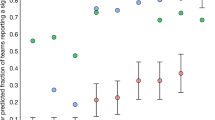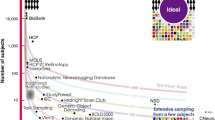Abstract
The enormous scale and complexity of data sets in functional neuroimaging makes it crucial to have well-designed and flexible software for image processing, modeling, and statistical analysis. At present, researchers must choose between general purpose scientific computing environments (e.g., Splus and Matlab), and specialized human brain mapping packages that implement particular analysis strategies (e.g., AFNI, SPM, VoxBo, FSL or FIASCO). For the vast majority of users in Human Brain Mapping and Cognitive Neuroscience, general purpose computing environments provide an insufficient framework for a complex data-analysis regime. On the other hand, the operational particulars of more specialized neuroimaging analysis packages are difficult or impossible to modify and provide little transparency or flexibility to the user for approaches other than massively multiple comparisons based on inferential statistics derived from linear models.
In order to address these problems, we have developed open-source software that allows a wide array of data analysis procedures. The RUMBA software includes programming tools that simplify the development of novel methods, and accommodates data in several standard image formats. A scripting interface, along with programming libraries, defines a number of useful analytic procedures, and provides an interface to data analysis procedures. The software also supports a graphical functional programming environment for implementing data analysis streams based on modular functional components. With these features, the RUMBA software provides researchers programmability, reusability, modular analysis tools, novel data analysis streams, and an analysis environment in which multiple approaches can be contrasted and compared. The RUMBA software retains the flexibility of general scientific computing environments while adding a framework in which both experts and novices can develop and adapt neuroimaging-specific analyses.
Similar content being viewed by others
References
Aguirre, G., Zarahn, E., and D’Esposito, M. (1998) A critique of the use of the Kolmogorov-Smirnov (KS) statistic for the analysis of BOLD fMRI data. Magn. Reson. Med. 39(3), 500–505.
Bandettini, P., Jesmanowicz, A., Wong, E., and Hyde, J. (1993) Processing strategies for time-course data sets in functional MRI of the human brain. Magn. Reson. Med. 30(2), 161–173.
Bly, B. (1999) Latent structure analysis and boot-strapping as an alternative to parametric mapping. In: 13th conference on Neural Information Processing Systems.
Bly, B. and Griswold, M. (1997) fmri data analysis with minimal assumptions. In: Proceedings of the 11th meeting of the Neural Information Processing Society, Denver, CO.
Bly, B., Rebbechi, D., and Hanson, S. (2004a) The general linear model and residual structure in neuroimaging data. Submitted.
Bly, B., Rebbechi, D., and Hanson, S. (2004b) A lognormal noise model improves fitting of bold fmri data. Submitted.
Cox, R. (1996) AFNI: software for analysis and visualization of functional magnetic resonance neuroimages. Comput. Biomed. Res. 29(3), 162–173.
Cox, R. and Hyde, J. (1997) Software tools for analysis and visualization of fMRI data. NMR Biomed. 10(4–5), 171–178.
Fissell, K., Tseytlin, E., Cunningham, D., et al. (2003) Fiswidgets: A graphical computing environment for neuroimaging analysis. Neuroinformatics 1(1). 111–126.
Gold, S., Christian, B., Arndt, S., et al. (1998) Functional mri statistical software packages: a comparative analysis. Human Brain Mapping 6, 73–84.
Hansen, L., Larsen, J., Nielsen, F., et al. (1999) Generalizable patterns in neuroimaging: how many principal components? Neuroimage 9(5), 534–544.
Hanson, S. and Bly, B. (2001) The distribution of BOLD susceptibility effects in the brain is non-Gaussian. Neuroreport. 12(9), 1971–1977.
Holmes, A., Blair, R., Watson, J., and Ford, I. (1996) Nonparametric analysis of statistic images from functional mapping experiments. J. Cereb. Blood Flow Metab. 16(1), 7–22.
Lange, N., Strother, S., Anderson, J., et al. (1999) Plurality and resemblance in fMRI data analysis. Neuroimage 10(3 Pt 1), 282–303.
Ogawa, S., Lee, T., Kay, A., and Tank, D. (1990) Brain magnetic resonance imaging with contrast dependent on blood oxygenation. Proc. Natl. Acad. Sci. 87(24), 9868–9872.
Rex, D. E., Ma, J. Q., and Toga, A. W. (2003) The LONI pipeline processing environment. Neuroimage 19(3), 1033–1048.
Siewert, B., Bly, B., Schlaug, G., et al. (1996) Comparison of the BOLD- and EPISTAR-technique for functional brain imaging by using signal detection theory. Magn. Reson. Med. 36(2), 249–255.
Strother, S., Kanno, I., and Rottenberg, D. (1995) Commentary and opinion: I. Principal component analysis, variance partitioning, and “functional connectivity”. J. Cereb. Blood Flow Metab. 15(3), 353–360.
Woods, R., Grafton, S., Watson, J., Sicotte, N., and Mazziotta, J. (1998) Automated image registration: Ii. Intersubject validation of linear and nonlinear models. J. Comp. Assist. Tomog. 22, 153–165.
Worsley, K. and Friston, K. (1995) Analysis of fMRI time-series revisite.
Author information
Authors and Affiliations
Corresponding author
Rights and permissions
About this article
Cite this article
Bly, B.M., Rebbechi, D., Hanson, S.J. et al. The RUMBA software. Neuroinform 2, 71–100 (2004). https://doi.org/10.1385/NI:2:1:071
Issue Date:
DOI: https://doi.org/10.1385/NI:2:1:071




